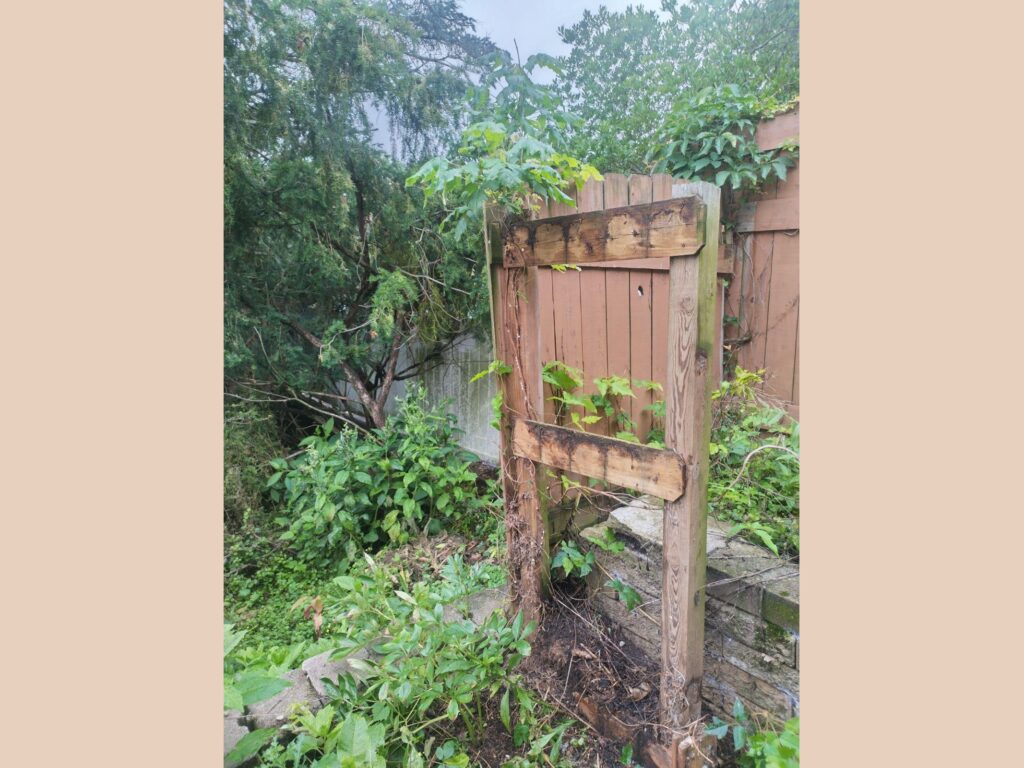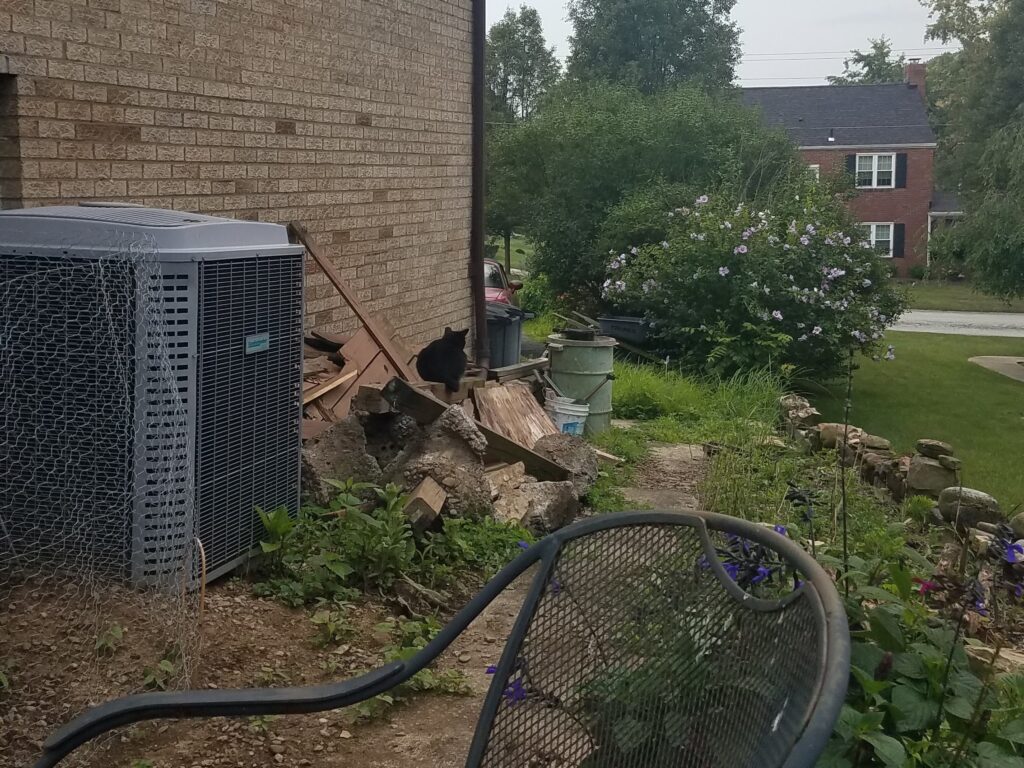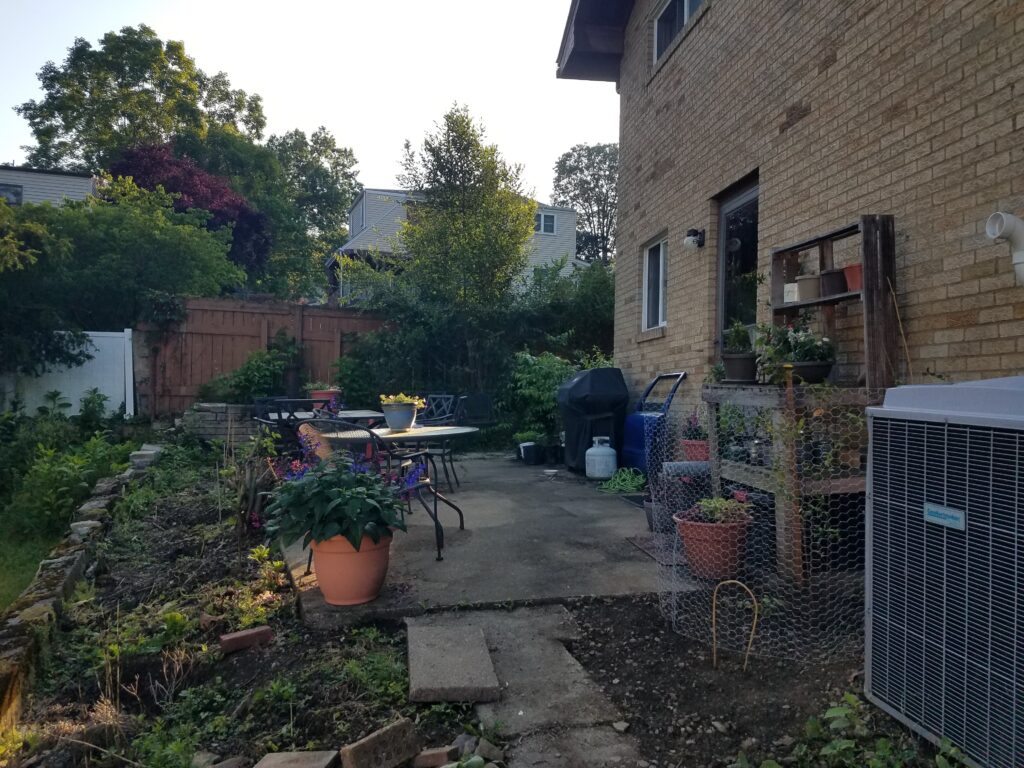I’ve been talking about tearing down the fence around our back porch for years, possibly since before I moved in. I even published a blog post in May about the hedge I will be planting in its place, [1] and then purchased the seven spicebush plants to ensure it happened this year. As part of this fence demolition and replacement process, I learned a good bit about what treated wood is and what you shouldn’t do with it.
Burn Notice
Being mindful of how much waste I generate, I fully planned to add the remains of the fence to our woodpile and eventually burn them in our fire pit. I know I have seen treated wood on bonfires before, so it didn’t really strike me as a problem. At some point or another (long before the fence ever came down), it came to my attention that treated wood should not be burned, so I tried to figure out exactly what we should do with it instead. Ultimately, the answer is send it to the landfill, which I disliked because I am averse to landfilling anything that could serve another purpose. But if the options are landfill or burn, the correct answer is landfill.
I don’t know how old the fence was, but it was in bad shape when Christian bought the house over ten years ago. Given that, it is plausible that the fence predated 2004, when new EPA safety standards kicked in for the chemicals in treated wood. Prior to 2004, pressure-treated lumber contained Chromated Copper Arsenate (CCA). While that chemical compound prevents termites, carpenter ants, carpenter bees, and the like from undermining the wood, it also raises questions of health concerns because of the arsenic content.

Some health services provide specific recommendations on where CCA-treated wood should and should not be used. For instance, Health Canada recommends avoiding the use of treated wood where it might come into contact with food (including compost bins or edging for a food garden); near livestock, feed, or food-producing animals; where it might come into contact with drinking water; or as mulch. You should apply a sealant annually (oil- or water-based stain, not paint, which can flake or chip) to help limit chemicals leaching from the wood; you should not use bleaching agents when cleaning it (which can cause wood to release chemicals that can be inhaled).[2] And, it should go without saying, that burning it can also cause those chemicals to be inhaled.
Under Pressure
The pressure treating process involves sending lumber into a sealed tank, evacuating the air, and forcing a chemical mixture into it at high pressure; the chemical mixture is designed to prevent degradation from pests and decay. Because the wood swells with the chemicals after they are forced inside, it can also crack over time as the wood dries out. Cracks in the wood can help the chemicals leach out more easily, but even wood that is properly cared for can leach chemicals into the soil nearby. [3]
One source claims that information from the Agency for Toxic Substances and Disease Registry (ATSDR) states that we can ingest “up to 0.3 micrograms of inorganic arsenic per kilogram of body weight per day and not be harmed,” indicating that chronic exposure from CCA-treated wood in residential settings does not approach toxic levels. (A source from the USDA also quoted here agrees that the exposure level is small enough not to be a problem.) The same article explains that plants tend to store arsenic in their roots, so things like carrots and radishes would be most impacted by cultivation near CCA-treated wood, while other types of food would be less so. [4]

The preservatives used in treated wood today are Alkaline Copper Quaternary (ACQ, or “quat”) and Copper Azole (CA), both of which make use of copper as a biocide to prevent fungal, microbial, and insect decay. Although they have been formulated to be a safer alternative to the arsenic-containing treatment, there are still concerns about the impacts of these chemicals in environmental and occupational settings. [5] Given that, I wanted to look at what alternatives were available for people who might be undertaking any outdoor lumber projects.
Available Alternatives
My first stop in looking at commonly touted construction materials for outdoor projects was a trade website. I don’t know why I was so shocked and disappointed to see a list so obviously not focused on sustainable alternatives, but that’s exactly what I found: several options that I personally would dismiss out of hand because of their adverse impacts to the environment and public health.
Unfortunately, there aren’t many options in construction that don’t have significant environmental and/or health impacts in one way or another, but this website listed several petroleum-based products, such as polymer composites, vinyl, and PVC. [6] I’ve written extensively on this blog about my desire to avoid plastics as much as possible because of the health impacts to people living in fenceline communities near fuel extraction, plastic processing activities, and transportation corridors (such as East Palestine, OH), not to mention the growing issues of plastic waste and microplastics everywhere. [7]

However, one of the options mentioned was Trex decking, which is a composite of sawdust and plastic. [8] It has been my understanding for years that the company makes use of plastic bags, which generally can’t be recycled, only downcycled. I still hold out hope that Trex is a good option, since it is a durable good that doesn’t make use of virgin plastic… but I also have very strong opinions about the fact that providing any kind of plastic “recycling” makes us all less vigilant about using less in the first place.
A green building website made some recommendations that I found to be far more reasonable, suggesting that local stone was the most environmentally friendly option to be used wherever possible in outdoor applications. There are also types of wood that have natural decay-resistant properties without needing to be treated, such as black locust, red mulberry, Osage orange, Pacific yew, cedars, oaks, junipers, and others. (They do note concerns about sustainable forestry practices for redwood and cedar options, so always make sure you’re checking your sources.) Finally, they do say that if you do have to use treated wood, it’s an option, but just make sure you’re following proper precautions to protect your family and the environment around you. [9]
~
I don’t plan to have us building anything outside in the very near future, but for when we do, I want to keep these options in mind. For now, I’m thrilled that the fence is gone, even if it had to go to the landfill. Have you used any treated wood alternatives in your outdoor projects? I’d love to hear about your experiences below.
Thanks for reading!
[1] https://radicalmoderate.online/spicebush-planting-a-native-hedge/
[3] https://www.finegardening.com/article/does-pressure-treated-wood-belong-in-your-garden
[4] https://www.finegardening.com/article/does-pressure-treated-wood-belong-in-your-garden
[5] https://www.ncbi.nlm.nih.gov/pmc/articles/PMC8996127/
[6] https://trustedpros.com/articles/decks/7-alternatives-to-pressure-treated-decking
[7] https://radicalmoderate.online/tag/plastic-free/
[9] https://www.buildinggreen.com/feature/pressure-treated-wood-how-bad-it-and-what-are-alternatives
0 Comments